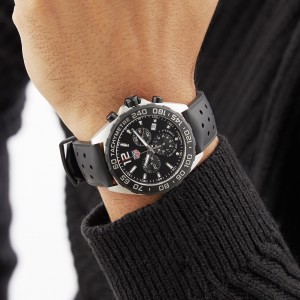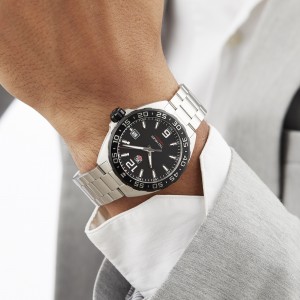 Rolex has earned its moniker, “The Crown,” through unparalleled dominance in the world of horology. Its enduring reign stems from a potent combination: iconic designs that transcend fleeting trends, peerless craftsmanship built to last generations, and a cultural cachet that remains firmly locked in place. This potent alchemy makes Rolex not just a watch, but often a sound investment. As Dillon Bhatt, watch expert and founder of LuxForte, observes, “Rolex has always been one of the most coveted brands globally precisely because it eschews pretense. They execute the fundamentals flawlessly, while simultaneously cultivating a hidden world of extraordinary artistry – off-catalogue creations, gem-encrusted marvels, and rare dials accessible only to discerning collectors. There truly exists a Rolex for every aspiration and budget, whether it marks your inaugural purchase or your centennial acquisition.”
Rolex has earned its moniker, “The Crown,” through unparalleled dominance in the world of horology. Its enduring reign stems from a potent combination: iconic designs that transcend fleeting trends, peerless craftsmanship built to last generations, and a cultural cachet that remains firmly locked in place. This potent alchemy makes Rolex not just a watch, but often a sound investment. As Dillon Bhatt, watch expert and founder of LuxForte, observes, “Rolex has always been one of the most coveted brands globally precisely because it eschews pretense. They execute the fundamentals flawlessly, while simultaneously cultivating a hidden world of extraordinary artistry – off-catalogue creations, gem-encrusted marvels, and rare dials accessible only to discerning collectors. There truly exists a Rolex for every aspiration and budget, whether it marks your inaugural purchase or your centennial acquisition.”
However, this universal desirability, coupled with deliberately constrained production, renders certain models exceptionally difficult to acquire. This scarcity naturally bolsters their ability to retain and appreciate in value over time. For the aspiring investor or collector, the critical question becomes: which Rolex models represent the most prudent investment?
Bhatt offers a perspective grounded in passion rather than pure speculation: “Choose the watch that captivates you instantly, the one that quickens your pulse. The volatility of the past few years taught us a harsh lesson: what rockets up can plummet just as fast. A watch should be acquired primarily for the joy of wearing it, not as a sterile asset locked away hoping to outperform volatile markets.” He notes a significant resurgence in vintage Rolex, particularly models featuring the vibrant ‘Stella’ enamel dials from the 1970s. These dials, named after the now-defunct Swiss lacquer supplier, have consistently commanded strong auction results. The playful appeal of these pieces is undeniable, evidenced by icons like Justin Bieber sporting a ‘money-green’ Stella dial and Victoria Beckham favouring a yellow-gold Datejust with aqua-green Stella. The frenzy surrounding the 2020 Oyster Perpetual models with their multicoloured ‘Celebration’ dials, adored by figures like Kendrick Lamar, further underscores the enduring power of bold colour in Rolex history, even if those specific models are now discontinued.
 Echoing the vintage sentiment, Brendan Cunningham, Professor of Economics and author of a book on Rolex, champions the unconventional Rolex King Midas. “The asymmetrically cased King Midas stands out as a remarkably versatile collectible,” Cunningham asserts. Representing an important chapter in Rolex’s dress watch heritage, examples on leather straps showing moderate wear can still be found in the mid-to-upper four figures (USD), while pristine models with their original precious metal bracelets approach $50,000. Cunningham believes significant potential remains: “I see considerable upside. Rolex is actively revitalizing its dress watch offerings, which should renew interest in the Midas as a cornerstone of that legacy.” He points to the current trend favouring distinctive dress watches, a category the Midas (a favourite of The Weeknd) perfectly embodies. Cunningham adds, “Persistent rumours of an official Rolex museum could shed fascinating new light on the Midas’s origins, inevitably reigniting collector passion.”
Echoing the vintage sentiment, Brendan Cunningham, Professor of Economics and author of a book on Rolex, champions the unconventional Rolex King Midas. “The asymmetrically cased King Midas stands out as a remarkably versatile collectible,” Cunningham asserts. Representing an important chapter in Rolex’s dress watch heritage, examples on leather straps showing moderate wear can still be found in the mid-to-upper four figures (USD), while pristine models with their original precious metal bracelets approach $50,000. Cunningham believes significant potential remains: “I see considerable upside. Rolex is actively revitalizing its dress watch offerings, which should renew interest in the Midas as a cornerstone of that legacy.” He points to the current trend favouring distinctive dress watches, a category the Midas (a favourite of The Weeknd) perfectly embodies. Cunningham adds, “Persistent rumours of an official Rolex museum could shed fascinating new light on the Midas’s origins, inevitably reigniting collector passion.”
Kenichi Abe, representing Tokyo’s renowned watch emporium Jack Road, concurs on the appeal of vintage, particularly 1970s pieces, while acknowledging their increasing scarcity. Abe directs significant attention to two modern icons. First, the Daytona, elevated to legendary status by Paul Newman and cherished by figures like John Mayer and Ed Sheeran (who, Abe notes approvingly, mirrors Newman’s preference for a leather strap). “Born for motorsport to calculate speed, the Daytona became truly iconic through Newman’s association,” Abe explains. His second recommendation is the GMT-Master II, originally crafted for Pan-Am pilots navigating time zones. Abe personally favours the brown dial variant for both models, a choice shared by David Beckham, and highlights the recent release of a more casual GMT-Master II iteration featuring a sleek black and grey bezel.
 Abe concludes with crucial advice transcending model choice: “Preservation is paramount. For a vintage treasure, meticulous servicing every three to five years is non-negotiable. This disciplined care ensures the watch endures, potentially becoming a legacy piece for generations to come.” The true value of a Rolex, as these experts subtly affirm, lies not only in its market potential but in its enduring story and the pleasure of its presence on the wrist, meticulously maintained as a testament to timeless craftsmanship.
Abe concludes with crucial advice transcending model choice: “Preservation is paramount. For a vintage treasure, meticulous servicing every three to five years is non-negotiable. This disciplined care ensures the watch endures, potentially becoming a legacy piece for generations to come.” The true value of a Rolex, as these experts subtly affirm, lies not only in its market potential but in its enduring story and the pleasure of its presence on the wrist, meticulously maintained as a testament to timeless craftsmanship.